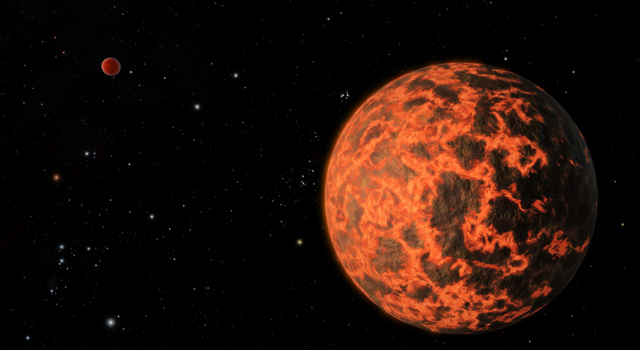Caption: This artist’s concept shows what astronomers believe is an alien world just two-thirds the size of Earth. Image credit: NASA/JPL-Caltech
Astronomers have detected what could be one of the smallest exoplanets found so far, just two-thirds the size of Earth. And, cosmically speaking, it’s in our neighborhood, at just 33 light-years away. But this planet, called UCF-1.01, is not a world most Earthlings would enjoy visiting: it likely is covered in magma.
“We have found strong evidence for a very small, very hot and very near planet with the help of the Spitzer Space Telescope,” said Kevin Stevenson from the University of Central Florida in Orlando, lead author of a new paper in The Astrophysical Journal. “Identifying nearby small planets such as UCF-1.01 may one day lead to their characterization using future instruments.”
This is the first time an exoplanet has been found using Spitzer, so astronomers are now rethinking this space telescope’s role in helping discover potentially habitable, terrestrial-sized worlds.
However, the hot, new-planet candidate was found unexpectedly in Spitzer observations. Stevenson and his colleagues were studying the Neptune-sized exoplanet GJ 436b, already known to exist around the red-dwarf star GJ 436. In the Spitzer data, the astronomers noticed slight dips in the amount of infrared light streaming from the star, separate from the dips caused by GJ 436b. A review of Spitzer archival data showed the dips were periodic, suggesting a second planet might be orbiting the star and blocking out a small fraction of the star’s light.
From the data, the astronomers were able to glean some basic properties of this exoplanet: its diameter is approximately 8,400 kilometers (5,200 miles ), or two-thirds that of Earth. UCF-1.01 would revolve quite tightly around its star, GJ 436, at about seven times the distance of Earth from the moon, with its “year” lasting only 1.4 Earth days. Given this proximity to its star, far closer than the planet Mercury is to our sun, the exoplanet’s surface temperature would be almost 600 degrees Celsius (about 1,000 degrees Fahrenheit).
The planet likely does not have an atmosphere, being so close to the star UCR-1.01’s might be a hot lava world.
“The planet could even be covered in magma,” said Joseph Harrington, also of the University of Central Florida and principal investigator of the research.
In addition to UCF-1.01, the researchers noticed hints of a third planet, dubbed UCF-1.02, orbiting GJ 436. Spitzer has observed evidence of the two new planets several times each. However, even the most sensitive instruments are unable to measure exoplanet masses as small as UCF-1.01 and UCF-1.02, which are perhaps only one-third the mass of Earth. Knowing the mass is required for confirming a discovery, so the paper authors are cautiously calling both bodies exoplanet candidates for now.
While this is Spitzer’s first potential extra solar planet, the exoplant-hunting Kepler spacecraft has identified 1,800 stars as candidates for having planetary systems, and just three are verified to contain sub-Earth-sized exoplanets. Of these, only one exoplanet is thought to be smaller than the Spitzer candidates, with a radius similar to Mars, or 57 percent that of Earth.
“I hope future observations will confirm these exciting results, which show Spitzer may be able to discover exoplanets as small as Mars,” said Michael Werner, Spitzer project scientist at NASA’s Jet Propulsion Laboratory in Pasadena, Calif. “Even after almost nine years in space, Spitzer’s observations continue to take us in new and important scientific directions.”


A scorched, almost earth-sized planet.
I wonder how much mass would be lost by extensive evaporation if the earth was scorched in a similar manner.
Here’s the recently released paper (PDF):
Two nearby sub-Earth-sized exoplanet candidates in the GJ 436 system.
congratulations with this find. Every day we come one step closer to find a true earth like planet
” is not a world most Earthlings would enjoy visiting: it likely is covered in magma”
I’d be more than happy to visit ANY other world. Even from orbit.
There appears to be a Brown Dwarf looking object in the system as well.
That’s… that’s not a photo
Continuing with Jason’s Star wars references in the early CGI Movie article, looks like we’ve found the Mustafar system!!